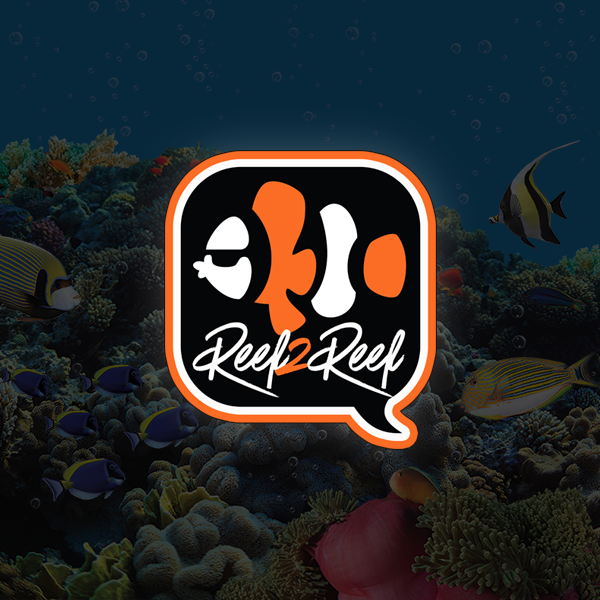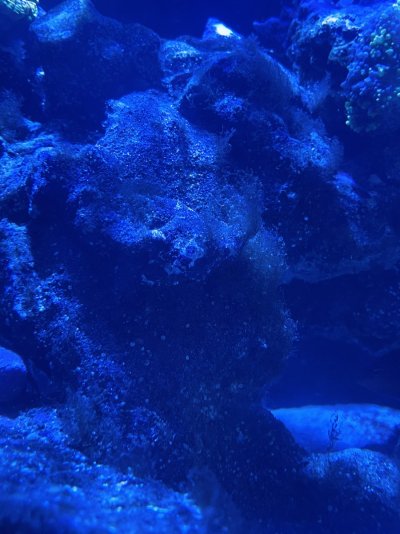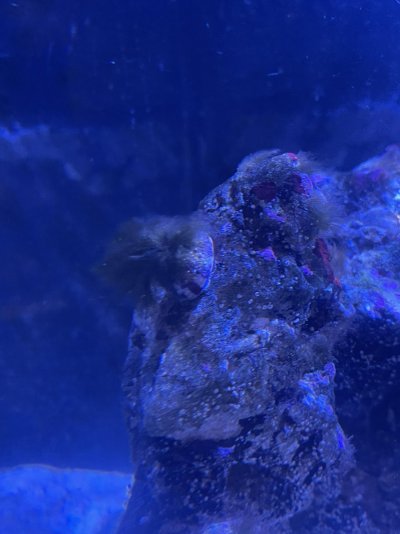Hi everyone! I have noticed a lot of this green algae in my tank lately that looks similar to hair algae, although it is much thicker. Every time that I try to scrub it off the rocks, it comes right back after a couple of days. Does anyone have any suggestion on how to get rid of it or anything that may eat it. (btw I have a 25gal lagoon.) TIA
Navigation
Install the app
How to install the app on iOS
Follow along with the video below to see how to install our site as a web app on your home screen.
Note: This feature may not be available in some browsers.
More options
You are using an out of date browser. It may not display this or other websites correctly.
You should upgrade or use an alternative browser.
You should upgrade or use an alternative browser.
Nuisance Algae
- Thread starter austin_socal
- Start date
- Tagged users None
NonstopSoda
Well-Known Member
View BadgesCatskill Reef Member
Louisiana Reef Club
SF Bay Reefer
Pacific Northwest Reefers
Midwest Reefer
Rocky Mountain Reefers
Alaska Reefer
My Tank Thread
any pics? if it is just GHA then i suggest adding copepods, astera snails, turbo snails, and nerite snails, but they wont eat the long strands so make sure to scrub them down so the snails will eat it.
Ok, thank you. Here is a photo of what it is looking like. Pretty hard to tell tho bc I scrubbed most of it off the rocks yesterday.any pics? if it is just GHA then i suggest adding copepods, astera snails, turbo snails, and nerite snails, but they wont eat the long strands so make sure to scrub them down so the snails will eat it.
Attachments
What do you mean?Get your hands wet daily
NonstopSoda
Well-Known Member
View BadgesCatskill Reef Member
Louisiana Reef Club
SF Bay Reefer
Pacific Northwest Reefers
Midwest Reefer
Rocky Mountain Reefers
Alaska Reefer
My Tank Thread
yup thats Green hair algae alright! stable parameters, a good CUC and of course getting your hands wet ( manual removal ) it should go away.Ok, thank you. Here is a photo of what it is looking like. Pretty hard to tell tho bc I scrubbed most of it off the rocks yesterday.
vetteguy53081
Well known Member and monster tank lover
View Badges
Partner Member 2024
Excellence Award
Reef Tank 365
RGB
Article Contributor
Tampa Bay Reef Keepers
West Palm Beach Reefer
Hospitality Award
Ocala Reef Club Member
305 Reef Club
Wisco Reefers
Midwest Reefer
Fish Medic
MAC of SW Florida
Rock Pool Reef Keepers
R2R Secret Santa 2023
My Tank Thread
My Aquarium Showcase
This is green hair algae. Did you scrub it off in the tank? If so , dontOk, thank you. Here is a photo of what it is looking like. Pretty hard to tell tho bc I scrubbed most of it off the rocks yesterday.
I would place it in a container of tank water and pull off as much as you can by hand and scrub the rest with a firm toothbrush and some 3% hydrogen peroxide.
Return to tank, reduce white light intensity and number of hours of white lighting and add some snails such as :
Astrea
cerith
turbo grazer
trochus
A Pencil urchin
8-10 Caribbean blue leg hermits
Are you using RODI water or tap water from the faucet ?
What is your phosphate level?
Is tank at or near a window?
What's the reasoning behind not scrubbing in the tank? Not disagreeing, just curious as to why.This is green hair algae. Did you scrub it off in the tank? If so , dont
I would place it in a container of tank water and pull off as much as you can by hand and scrub the rest with a firm toothbrush and some 3% hydrogen peroxide.
Return to tank, reduce white light intensity and number of hours of white lighting and add some snails such as :
Astrea
cerith
turbo grazer
trochus
A Pencil urchin
8-10 Caribbean blue leg hermits
Are you using RODI water or tap water from the faucet ?
What is your phosphate level?
Is tank at or near a window?
NonstopSoda
Well-Known Member
View BadgesCatskill Reef Member
Louisiana Reef Club
SF Bay Reefer
Pacific Northwest Reefers
Midwest Reefer
Rocky Mountain Reefers
Alaska Reefer
My Tank Thread
I second this : OWhat's the reasoning behind not scrubbing in the tank? Not disagreeing, just curious as to why.
Ok, thank you. I unfortunately cannot remove my rocks from the tank because I had glued them all together as the tank was originally only meant to house a frogfish but that just ended up not working out. It is now a reef tank. I also have been having large issues with dino's so my lights are currently blacked out. (I only turned them on for that picture before.) I have a tuxedo urchin right now by the way, should I still get another urchin or no?This is green hair algae. Did you scrub it off in the tank? If so , dont
I would place it in a container of tank water and pull off as much as you can by hand and scrub the rest with a firm toothbrush and some 3% hydrogen peroxide.
Return to tank, reduce white light intensity and number of hours of white lighting and add some snails such as :
Astrea
cerith
turbo grazer
trochus
A Pencil urchin
8-10 Caribbean blue leg hermits
Are you using RODI water or tap water from the faucet ?
What is your phosphate level?
Is tank at or near a window?
To answer your questions:
My tank is not near a window. I do not have an RODI machine, I am getting my water from my LFS so I am not sure if it is tap or faucet. My phosphate level is currently at about 0.25 ppm. (just to let you know- my tank is only a 25 gal)
Last edited:
Thank youyup thats Green hair algae alright! stable parameters, a good CUC and of course getting your hands wet ( manual removal ) it should go away.
vetteguy53081
Well known Member and monster tank lover
View Badges
Partner Member 2024
Excellence Award
Reef Tank 365
RGB
Article Contributor
Tampa Bay Reef Keepers
West Palm Beach Reefer
Hospitality Award
Ocala Reef Club Member
305 Reef Club
Wisco Reefers
Midwest Reefer
Fish Medic
MAC of SW Florida
Rock Pool Reef Keepers
R2R Secret Santa 2023
My Tank Thread
My Aquarium Showcase
Phos s
No light as you've started is the first key followed by the addition of bacteria to overcome the bad bacteria allowing them to thrive
Prepare by starting by blowing this stuff loose with a turkey baster and siphon up loose particles. Turn lights off (at least white and run blue at 10% IF you have light dependant corals such as SPS) for 5 days and at night dose 1ml of 3% hydrogen peroxide per 10 gallons for all 5 nights which works as an oxidizer. If you dont have light dependent coral- turn all lights off. During the day dose 1ml of liquid bacteria (such as micro bacter 7 or XLM) per 10 gallons. Clean filters daily and DO NOT FEED AMINO OR ADD NOPOX which is food for dinos, however you can feed coral, food which will help no3 and po4 to increase. If increasing nutrients, try to keep no3 to about 5 until you are done battling these cells.
Doing a daily siphoning will help greatly But . . . . . Siphoning will reduce nutrients , so siphon the water into/through a filter sock and save the water and return it back to tank. Obviously clean the filter sock each time.
You can feed fish as normal and if doing blackout, ambient light in room will work for them
Phos should be .02 range and test your lFS water to assure its not high in Phos, nitrate and PH. If blacked out, another urchin likely not needed. For dino, and this will help with algae, as it's biological deficiencies that are causing the dino structure and tank and Its important though to identify the type of dino for most effective battle.Ok, thank you. I unfortunately cannot remove my rocks from the tank because I had glued them all together as the tank was originally only meant to house a frogfish but that just ended up not working out. It is now a reef tank. I also have been having large issues with dino's so my lights are currently blacked out. (I only turned them on for that picture before.) I have a tuxedo urchin right now by the way, should I still get another urchin or no?
To answer your questions:
My tank is not near a window. I do not have an RODI machine, I am getting my water from my LFS so I am not sure if it is tap or faucet. My phosphate level is currently at about 0.25 ppm. (just to let you know- my tank is only a 25 gal)
No light as you've started is the first key followed by the addition of bacteria to overcome the bad bacteria allowing them to thrive
Prepare by starting by blowing this stuff loose with a turkey baster and siphon up loose particles. Turn lights off (at least white and run blue at 10% IF you have light dependant corals such as SPS) for 5 days and at night dose 1ml of 3% hydrogen peroxide per 10 gallons for all 5 nights which works as an oxidizer. If you dont have light dependent coral- turn all lights off. During the day dose 1ml of liquid bacteria (such as micro bacter 7 or XLM) per 10 gallons. Clean filters daily and DO NOT FEED AMINO OR ADD NOPOX which is food for dinos, however you can feed coral, food which will help no3 and po4 to increase. If increasing nutrients, try to keep no3 to about 5 until you are done battling these cells.
Doing a daily siphoning will help greatly But . . . . . Siphoning will reduce nutrients , so siphon the water into/through a filter sock and save the water and return it back to tank. Obviously clean the filter sock each time.
You can feed fish as normal and if doing blackout, ambient light in room will work for them
Ok, thank you so much man. I just have a couple questions:Phos
Phos should be .02 range and test your lFS water to assure its not high in Phos, nitrate and PH. If blacked out, another urchin likely not needed. For dino, and this will help with algae, as it's biological deficiencies that are causing the dino structure and tank and Its important though to identify the type of dino for most effective battle.
No light as you've started is the first key followed by the addition of bacteria to overcome the bad bacteria allowing them to thrive
Prepare by starting by blowing this stuff loose with a turkey baster and siphon up loose particles. Turn lights off (at least white and run blue at 10% IF you have light dependant corals such as SPS) for 5 days and at night dose 1ml of 3% hydrogen peroxide per 10 gallons for all 5 nights which works as an oxidizer. If you dont have light dependent coral- turn all lights off. During the day dose 1ml of liquid bacteria (such as micro bacter 7 or XLM) per 10 gallons. Clean filters daily and DO NOT FEED AMINO OR ADD NOPOX which is food for dinos, however you can feed coral, food which will help no3 and po4 to increase. If increasing nutrients, try to keep no3 to about 5 until you are done battling these cells.
Doing a daily siphoning will help greatly But . . . . . Siphoning will reduce nutrients , so siphon the water into/through a filter sock and save the water and return it back to tank. Obviously clean the filter sock each time.
You can feed fish as normal and if doing blackout, ambient light in room will work for them
How should I go about trying to lower my phos?
How many of the snails and such should I buy? (I will put in an order on AlgaeBarn tonight)
Do I not have to dose the tank with Hydrogen Peroxide if I don't have sps?
Do you think that something like a sand-sifting starfish would help the dinos on the sand bed?
thank you so much
vetteguy53081
Well known Member and monster tank lover
View Badges
Partner Member 2024
Excellence Award
Reef Tank 365
RGB
Article Contributor
Tampa Bay Reef Keepers
West Palm Beach Reefer
Hospitality Award
Ocala Reef Club Member
305 Reef Club
Wisco Reefers
Midwest Reefer
Fish Medic
MAC of SW Florida
Rock Pool Reef Keepers
R2R Secret Santa 2023
My Tank Thread
My Aquarium Showcase
You can reduce amount of food fedOk, thank you so much man. I just have a couple questions:
How should I go about trying to lower my phos?
How many of the snails and such should I buy? (I will put in an order on AlgaeBarn tonight)
Do I not have to dose the tank with Hydrogen Peroxide if I don't have sps?
Do you think that something like a sand-sifting starfish would help the dinos on the sand bed?
thank you so much
Do daily 2-3 gallon water changes for the next 10 days
Add a pouch od chemipure blue to sump
Do not use any tap water which often contain Phosphates
If feeding reef roids, that too will increase po4 level
Ok, thank you. btw I do not have a sump so is there anything I should change?You can reduce amount of food fed
Do daily 2-3 gallon water changes for the next 10 days
Add a pouch od chemipure blue to sump
Do not use any tap water which often contain Phosphates
If feeding reef roids, that too will increase po4 level
Daily manual removal by hand so eventually your cleaners will get ahead of it.What do you mean?
Hey Austin,
Not knowing your experience level, I would be cautious with dosing peroxide. Use a toothbrush dipped in peroxide and spot treat in tank as required.
Also, not knowing what other live stock you maintain; I run higher phosphate than you in a NPS tank with flame scallops & sea apples with no issues.

 www.reef2reef.com
www.reef2reef.com
In general, sand shifting starfish eat detrivores which are the janitors that maintain your substrate.
Instead, consider an urchin.
PS: I just read where you have an urchin already.
Not knowing your experience level, I would be cautious with dosing peroxide. Use a toothbrush dipped in peroxide and spot treat in tank as required.
Also, not knowing what other live stock you maintain; I run higher phosphate than you in a NPS tank with flame scallops & sea apples with no issues.

Take a walk on the wild side and go natural
My first journey into salt water was in the fall of 1971 when I set up a Galveston Bay bio-theme tank on a budget. For me, it was a no-brainer to go out and collect from the same eco-system that I hunted & fished in and on. So, fast forward a half century and Voila: I have come full circle and...
 www.reef2reef.com
www.reef2reef.com
In general, sand shifting starfish eat detrivores which are the janitors that maintain your substrate.
Instead, consider an urchin.
PS: I just read where you have an urchin already.
Last edited:
To further the point of initially the operator being the biggest janitor then allow cuc to maintain what is left.Daily manual removal by hand so eventually your cleaners will get ahead of it.
OP,
Most of the undesirable algae have the ability to release spores into the water. That is the reason behind not disturbing algae in tank. I pull the big stuff by hand then get a toothbrush dipped in peroxide, I use 12% concentrate but 3% from grocery store works fine. One technique to use is with a toothbrush to dislodge algae and airline tubing hose to syphon off what is dislodged. You can tape airline & toothbrush together and do this with one hand in the water.
Last edited:
Awesome, thank you so much!Hey Austin,
Not knowing your experience level, I would be cautious with dosing peroxide. Use a toothbrush dipped in peroxide and spot treat in tank as required.
Also, not knowing what other live stock you maintain; I run higher phosphate than you in a NPS tank with flame scallops & sea apples with no issues.

Take a walk on the wild side and go natural
My first journey into salt water was in the fall of 1971 when I set up a Galveston Bay bio-theme tank on a budget. For me, it was a no-brainer to go out and collect from the same eco-system that I hunted & fished in and on. So, fast forward a half century and Voila: I have come full circle and...www.reef2reef.com
In general, sand shifting starfish eat detrivores which are the janitors that maintain your substrate.
Instead, consider an urchin.
PS: I just read where you have an urchin already.
ah. thank you.Daily manual removal by hand so eventually your cleaners will get ahead of it.





















